How to Cook Japanese Beef Stew Meat
This post may incorporate affiliate links. Please read my disclosure policy for details. As an Amazon Associate, I earn from qualifying purchases.

With chunks of potatoes, onion, and thinly sliced beefiness simmered in savory and sweet dashi broth, Japanese Meat and Potato Stew (Nikujaga) is one of the most iconic abode-cooked dishes in Nihon.
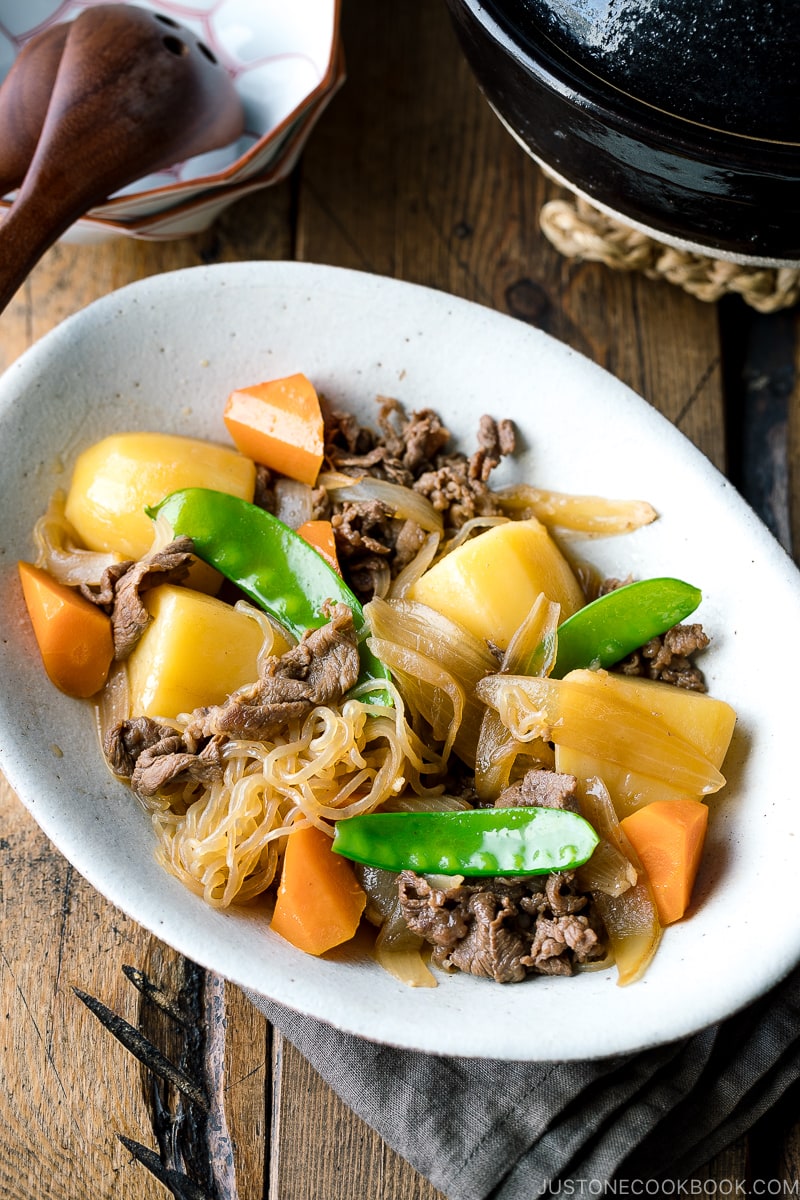
Nikujaga (肉じゃが) or Japanese Meat and Tater Stew is synonymous with the good quondam home cooking in Nippon. Information technology'south the dish that everyone frequently eats at dwelling house and remembers as mother'southward taste おふくろの味. Let'due south make a killer Nikujaga that steals your family's heart!
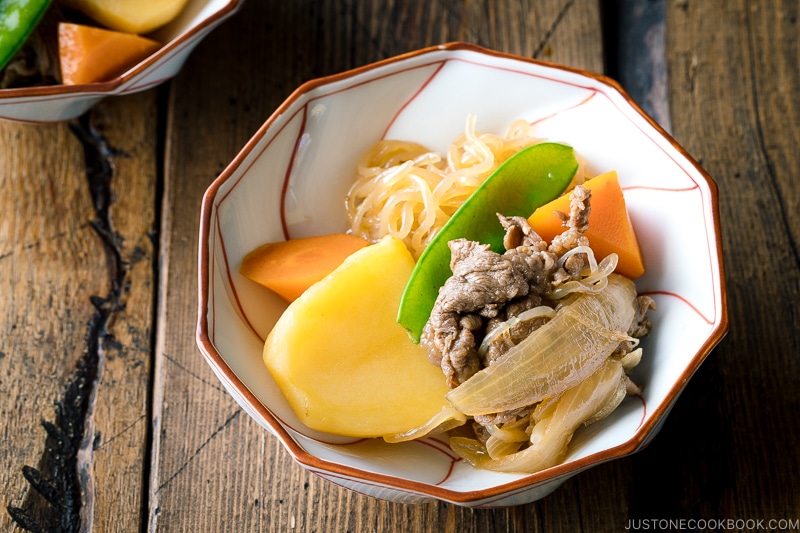
What is Nikujaga
Equally two of the chief ingredients are niku (meat) and jagaimo (potatoes), Nikujaga (肉じゃが) literally means "meat and potatoes". It is an iconic Japanese home-cooked dish, known as "Ofukuro no Aji" – taste of female parent's cooking. For many, nikujaga is an honest-to-goodness comfort food.
Potatoes make upward the majority of the dish, with some thinly sliced beef or pork, onion, shirataki noodles (ito konnyaku), and colorful mix of vegetables. In western Japan, nikujaga typically features beefiness while pork is more commonly used in eastern Nippon.
It is a classic Yoshoku, a western-influenced Japanese food, appeared in the tardily nineteenth century. Hither, the ingredients are stewed in soy sauce, carbohydrate, sake, and mirin, forth with dashi (or h2o) in a pot, rendering a familiar Japanese flavour.
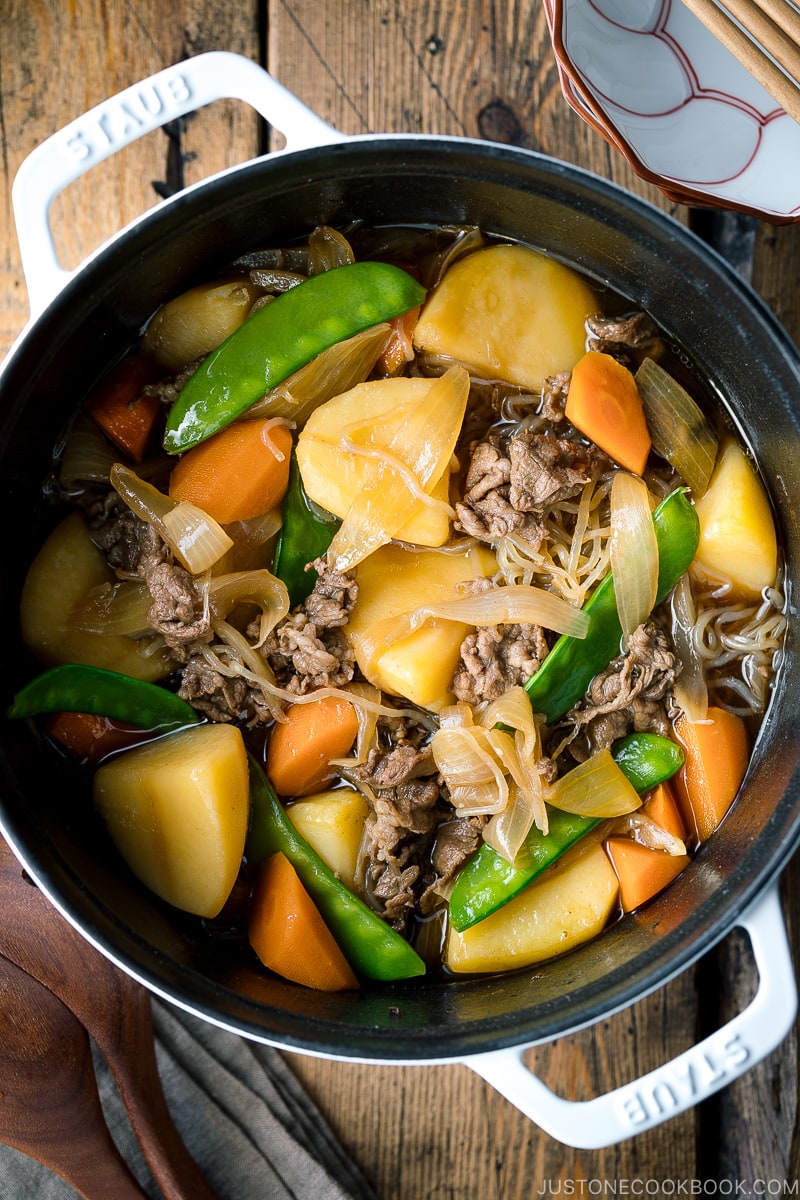
History of Nikujaga
Nikujaga originated in the Imperial Japanese Navy. It was introduced to sailors as it was high in diet and the ingredients are easy to supply as they are similar to the ones for Navy Curry.
In the late 19thursday century, Full general Heihachiro Togo who studied in Portsmouth, England in tardily 1800s, asked the naval cook to create a version of the beef stew, which was served in the British Royal Navy. As the chef never tried beef stew earlier and ingredients like wine and demi glace sauce were not available then, the chef invented his own version with soy sauce and sugar, similar to Sukiyaki. The dish, called Amani (甘煮) back then, became popular in the Navy, which you can find the recipe in the "Navy kitchen textbook."
On the contrary, the general public didn't show interest in the dish as it uses beef and potatoes that were foreign to the Japanese at the time. Nikujaga didn't appear on the table at home until the 1970s. That's when beef stew and curry rice started to become pop and home cooks started to use beef and potatoes in their cooking.
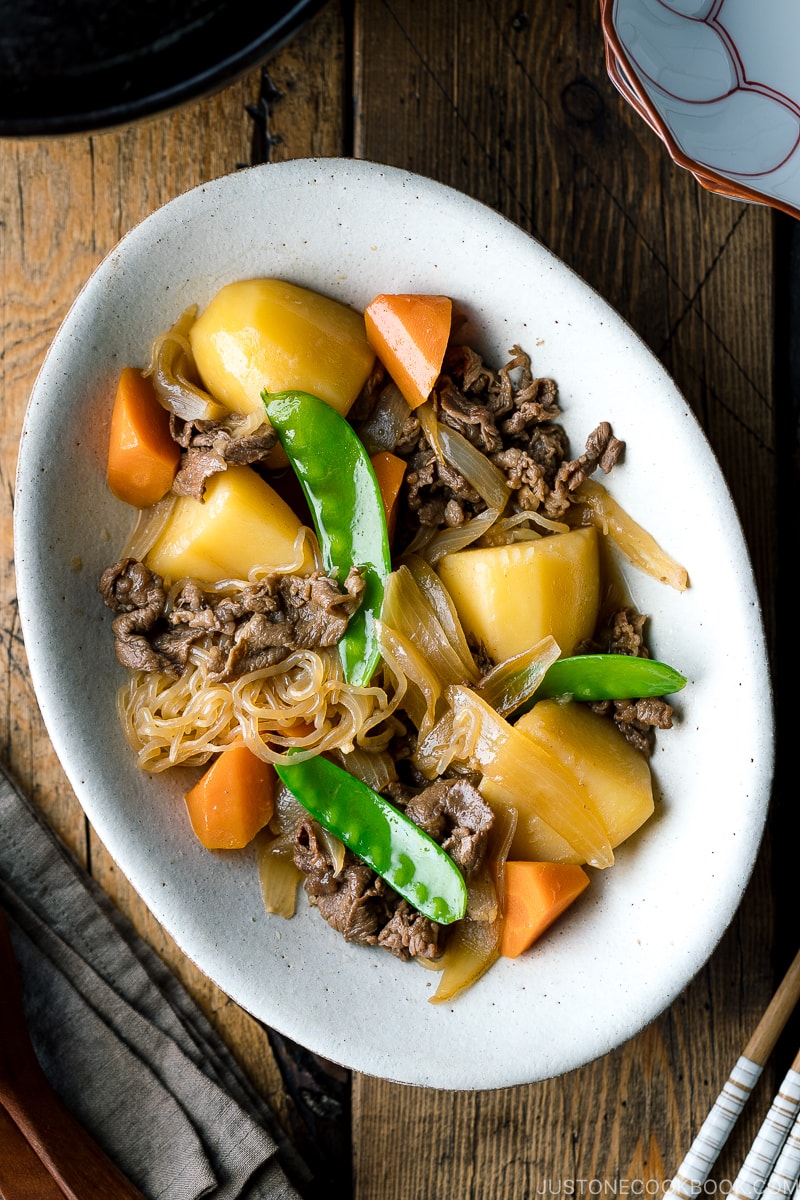
How to Make Nikujaga
Ingredients You'll Demand
- Potatoes
- Thinly sliced beef or pork (thinly sliced meat cooks a lot faster!)
- Onion
- Shirataki noodles (Ito Konnyaku)
- Carrot
- Green vegetables (Nigh normally snow peas, dark-green beans, or green peas)
- Seasonings – soy sauce, sugar, mirin, sake, optional dashi
Overview of Cooking Steps
- Flinch green vegetable of your choice in a separate modest pot. Set up aside for the last step.
- Cook shirataki noodles according to package directions.
- In a large pot, cook the onion and so add meat.
- Add potatoes and glaze them well with oil.
- Add the rest of ingredients, including shirataki noodles.
- Add seasonings and simmer for fifteen minutes.
- Allow absurd for xxx-60 minutes.
- When prepare to serve, add in fair-skinned light-green vegetable and reheat to serve.
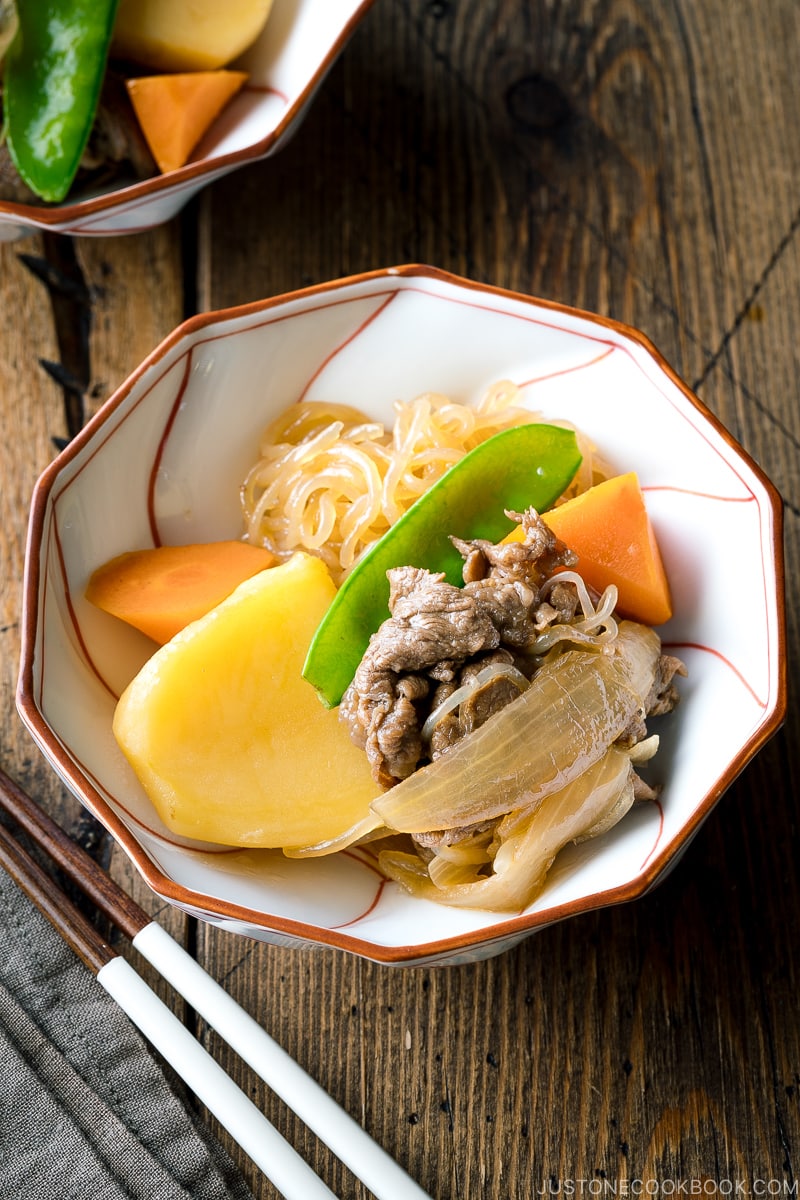
five Nearly Of import Tips to Brand Best Nikujaga
- Cutting the ingredients into roughly equal chunks and size – The ingredients should be all cooked in xv minutes or less. If you cut them too small or too large, the texture will either be mushy or undercooked.
- Utilize a bigger pot/pan – To make sure the ingredients absorb all the smashing flavors, it'southward all-time to use a wide, big pan or pot so the ingredients won't be overlapping too much and there is no need to mix frequently.
- Utilize Otoshibuta (Drib Lid) – This Japanese must-have tool keeps the ingredients in place while simmering so they will not motility and break down. Information technology also helps to circulate the broth over the surface then you don't demand to mix while cooking. Don't have 1? Make one with aluminum foil or parchment paper!
- Let cool after simmering – During cool down, the ingredients volition blot all the flavors.
- Add together green vegetable right before serving – I highly recommend blanching the light-green vegetables beginning, and reheat it right earlier serving. If yous cook them with the other ingredients, the color will not stay bright greenish.
What to Serve with Nikujaga
- Rice: Steamed rice, Takikomi Gohan
- Soup: Miso Soup, Kakitama Jiru (Japanese Egg Drop Soup)
- Sides: Grilled Mackerel (if you want more poly peptide), Spinach Ohitashi, Chilled Tofu, Light-green Bean Shiraae, Eggplant Agebitashi
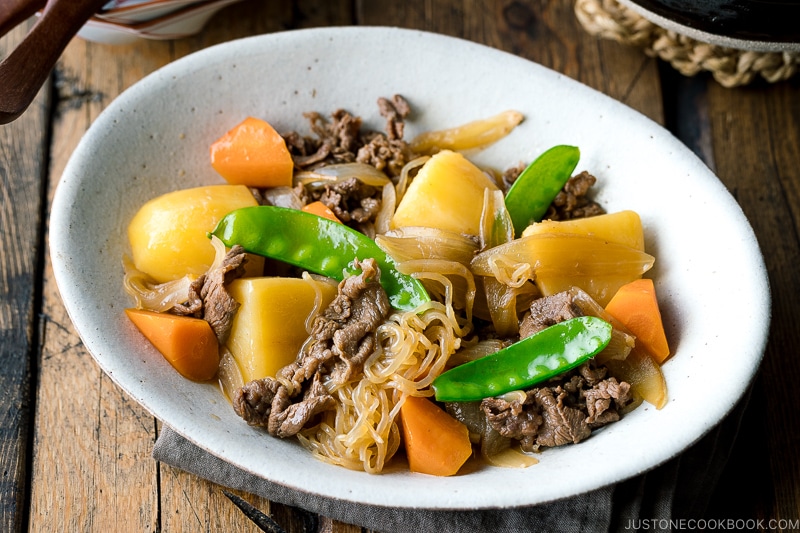
Sign upwardly for thecomplimentary newsletter delivered to your inbox and stay in touch with me on Facebook, Pinterest, YouTube, and Instagram for all the latest updates.
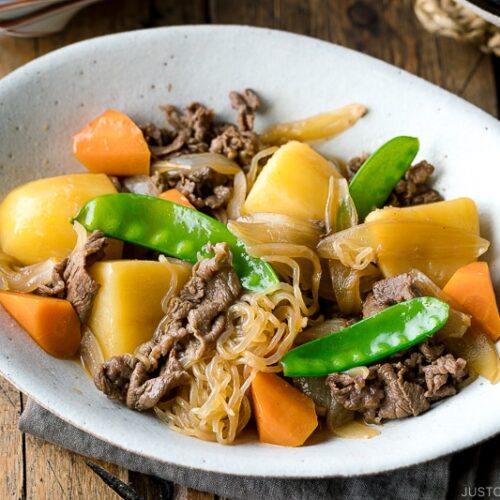
Nikujaga (Japanese Meat and Murphy Stew)
With chunks of potatoes, onion, and thinly sliced beef simmered in a savory-sweet dashi broth, Japanese Meat and Potato Stew (Nikujaga) is one of the most iconic home-cooked dishes in Nihon.
Servings: 4
Prevent your screen from going dark
- one onion (8.8 oz, 250 thousand for 4 servings)
- 1 carrot (four.five oz, 127 g for 4 servings)
- 3 Yukon gold potatoes (1.ii lb, 546 grand for iv servings; Yukon golds continue their shape better during simmering, but I sometimes apply russet potatoes, which tend to break hands merely absorb flavors nicely)
- one parcel shirataki noodles (7 oz, 200 yard for iv servings)
- ½ lb thinly sliced beef (chuck or rib middle) (you can besides use thinly sliced pork; skip for vegan/vegetarian and utilize shiitake, king oyster, or portabello mushrooms as a substitute)
- 8 pieces snow peas (you can also utilise green beans or green peas)
- i Tbsp neutral-flavored oil (vegetable, rice bran, canola, etc.)
Japanese Ingredient Commutation: If you want substitutes for Japanese condiments and ingredients, click here.
-
Get together all the ingredients.
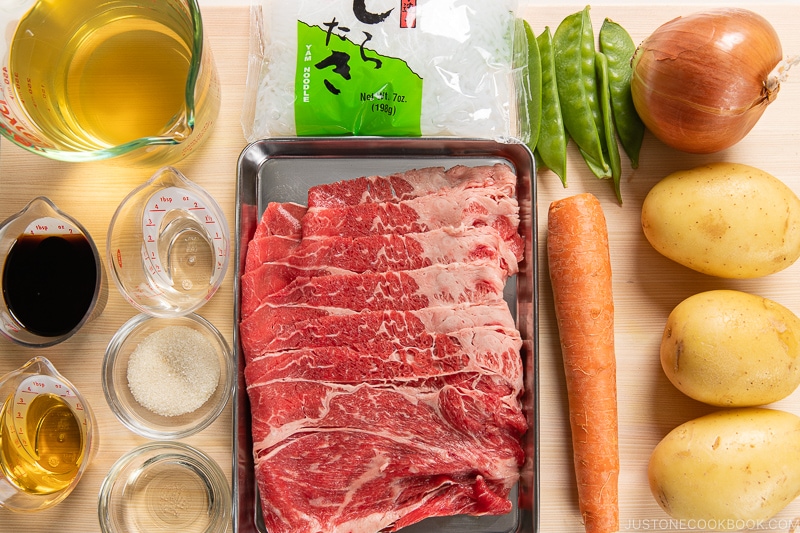
To Prepare the Ingredients
-
Cutting the onion in half, and cut each one-half into ½-inch (one.3 cm) wedges.
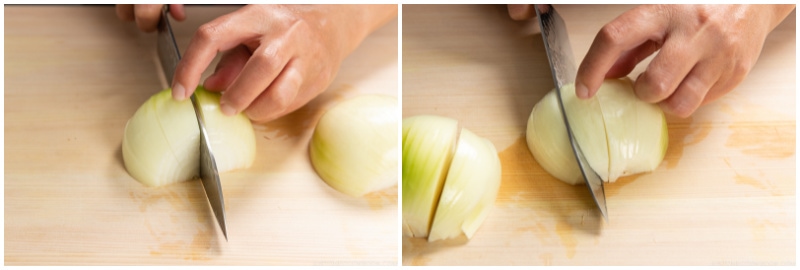
-
Pare the carrot and cutting it into 1-inch (2.5 cm) pieces. Here, I employ a Japanese cutting technique chosen "rangiri," where we cut the carrot diagonally while rotating it a quarter turn between cuts. This helps to create more area and so it will melt faster and blot more flavor.
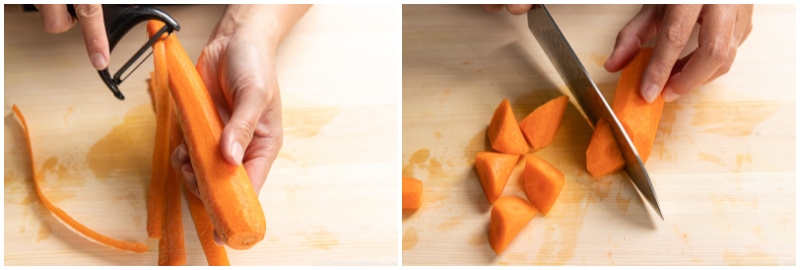
-
Cut each potato into quarters.
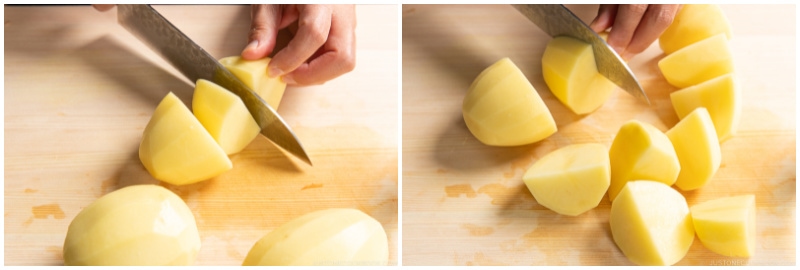
-
Remove the sharp edges of the potatoes with a knife to create smoothen corners. Then, soak the potatoes in h2o to remove the starch. Tip: Nosotros call this Japanese cutting technique "mentori." This prevents the potatoes from breaking into pieces. If the potatoes have abrupt edges, they are likely to bump into each other and interruption while simmering.
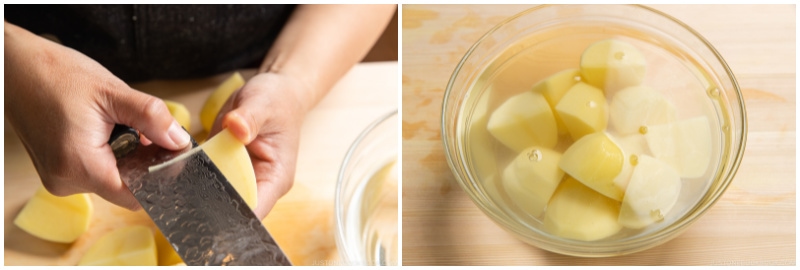
-
Remove the strings from the snow peas.
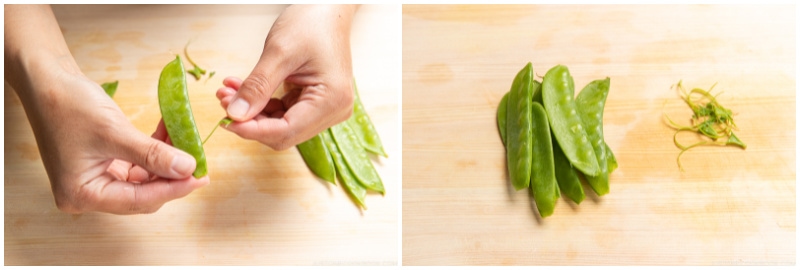
-
Bring a small pot of water to a boil and add a pinch of salt. Add the snowfall peas.
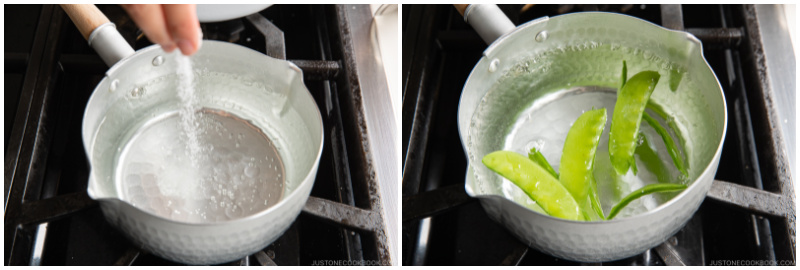
-
Blanch them in the humid water for 1 minute and take them out. Keep the water boiling.
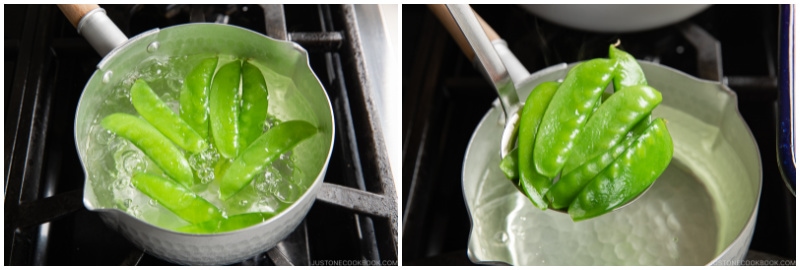
-
Bleed the shirataki noodles from the packet and cut them roughly in half. Flinch the noodles in the pot of humid water for one minute to remove any odor.
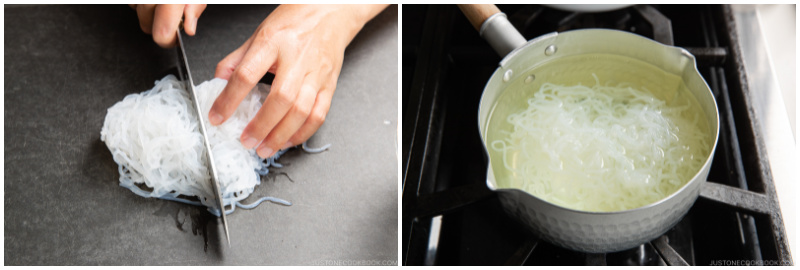
-
Drain well and gear up bated. Cut the thinly-sliced beef in half or thirds (depending on the size) so that the pieces are about three inches (seven.6 cm) wide.

To Cook the Nikujaga
-
Preheat a large pot or Dutch oven (I used a 4-QT Staub cocotte) on medium oestrus. Then, add the oil and sauté the onion wedges.
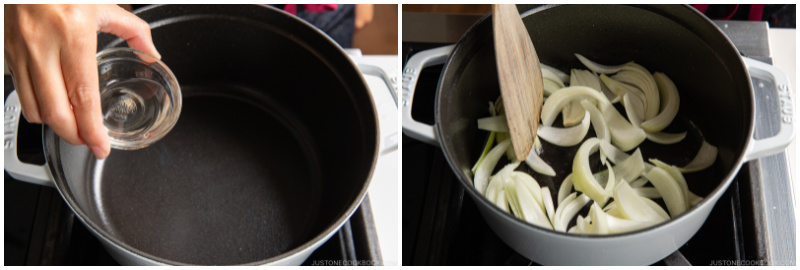
-
When the onion wedges are coated with oil, add the meat and melt until no longer pinkish.
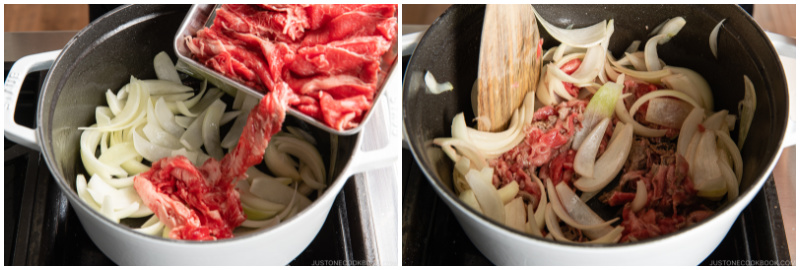
-
Add the potatoes and glaze them well with the cooking liquid. Tip: This coating volition help proceed the potatoes from breaking.
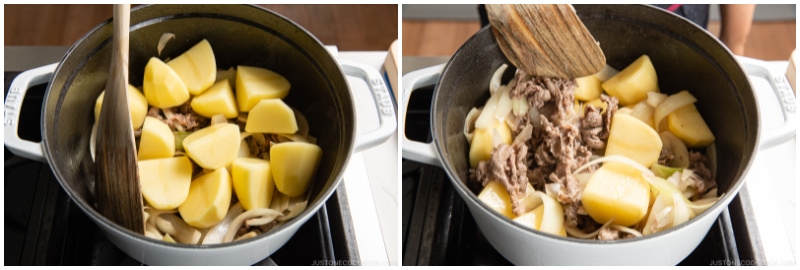
-
Add the carrot pieces and shirataki noodles and mix everything together.
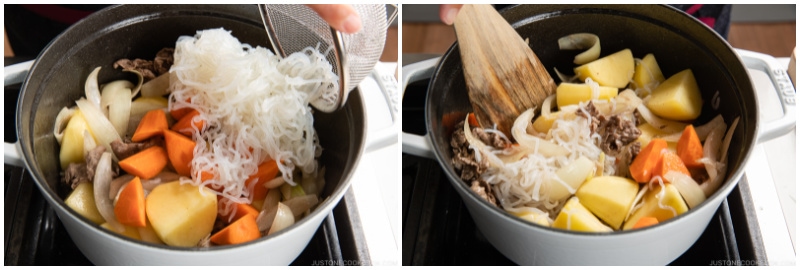
-
Add the dashi, making certain there's plenty liquid to nearly cover the ingredients (it doesn't have to fully cover the ingredients). If there'southward not enough liquid, add water.
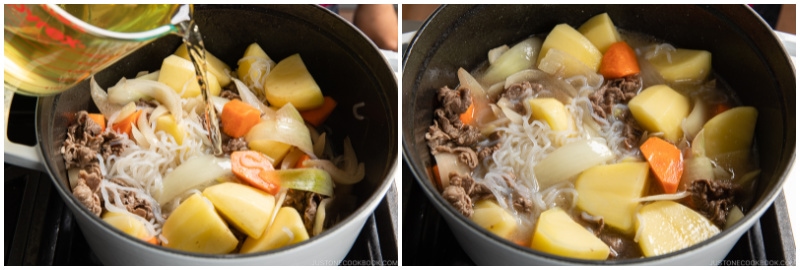
-
Cover with a lid and go along to cook. Once boiling, skim the scum and cream from the surface with a fine-mesh skimmer.
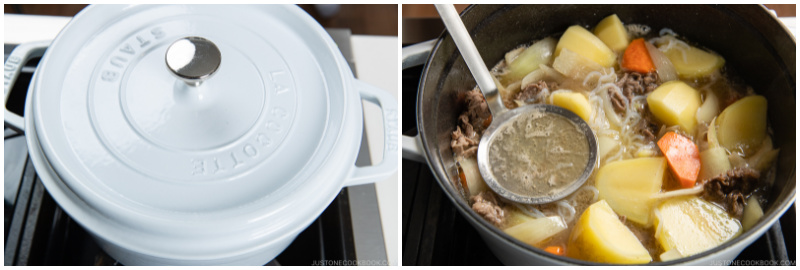
-
Add the sugar, sake, soy sauce, and mirin.
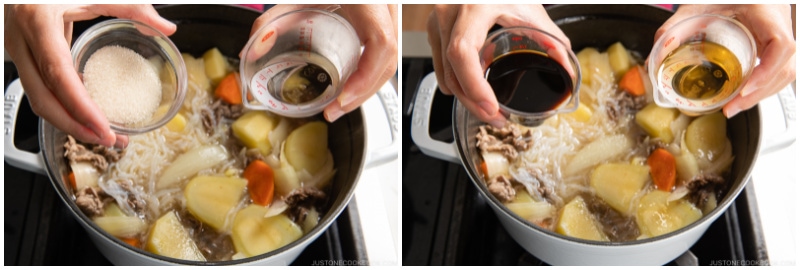
-
Mix it all together and place an otoshibuta (driblet hat) on elevation of the ingredients.
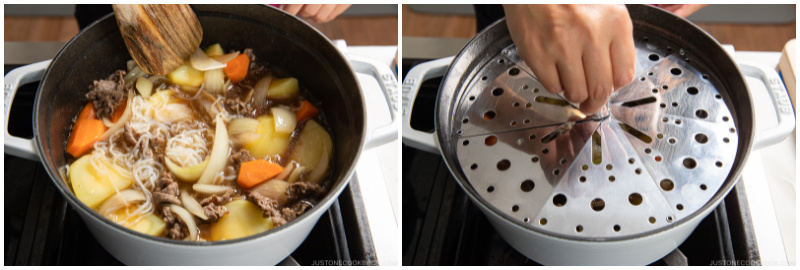
-
Simmer on depression oestrus for 12-xiv minutes, or until a skewer pierces a potato easily. Tip: The otoshibuta holds the ingredients in identify and is necessary to maintain the shape of the vegetables. They bump into each other and break easily when they are loose. Practice not mix the ingredients while cooking; the otoshibuta will help distribute the cooking liquid and its flavors.

-
Plow off the heat and remove the otoshibuta. Ideally, let information technology stand (uncovered) for 30-60 minutes before serving. The flavors will soak into the ingredients while cooling down.
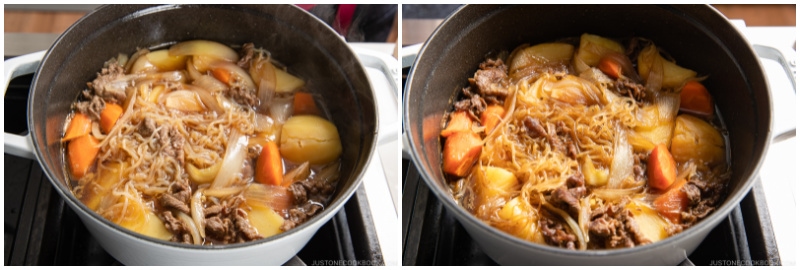
To Serve
-
When you are ready to serve the Nikujaga, add the blanched snow peas to the pot and embrace to reheat on medium estrus. When simmering, reduce the oestrus and let it simmer for a few minutes. Tip: Add the snowfall peas right earlier serving to proceed their bright color.
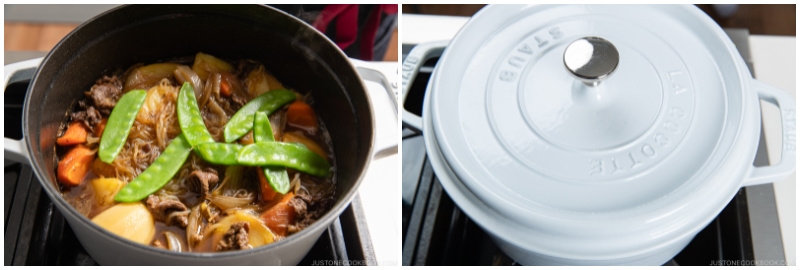
-
Turn off the oestrus and serve the Nikujaga with some cooking liquid in a big serving basin or individual bowls.
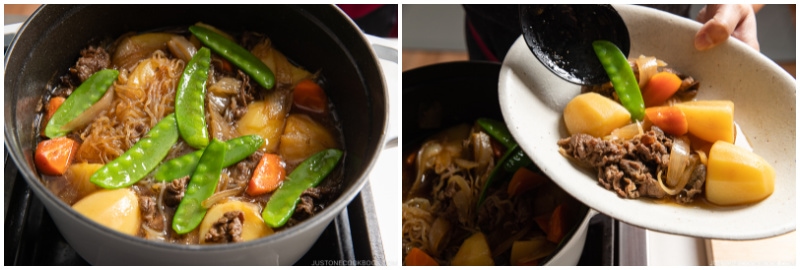
To Store
-
You can keep the leftovers in an airtight container or in the pot and store in the refrigerator for upwards to 3-4 days. Nikujaga tastes even better on the second 24-hour interval! To freeze, remove the potatoes equally their texture changes when frozen. You can keep it in the freezer for up to a month.
Calories: 338 kcal · Carbohydrates: 39 one thousand · Protein: 17 g · Fat: 11 k · Saturated Fat: 6 g · Polyunsaturated Fat: ane g · Monounsaturated Fatty: 4 k · Cholesterol: 35 mg · Sodium: 737 mg · Potassium: 937 mg · Fiber: 5 g · Carbohydrate: ten g · Vitamin A: 5391 IU · Vitamin C: 37 mg · Calcium: 49 mg · Atomic number 26: 2 mg
Course: Main Course
Cuisine: Japanese
Keyword: beefiness, potato
©JustOneCookbook.com Content and photographs are copyright protected. Sharing of this recipe is both encouraged and appreciated. Copying and/or pasting full recipes to any website or social media is strictly prohibited. Delight view my photo use policy here.
If you made this recipe, snap a pic and hashtag information technology #justonecookbook! We love to run across your creations on Instagram @justonecookbook!
Editor's Note: The mail service was originally published on April 19, 2012. New images and video have been added to the post and the content has been updated.
Subscribe Now!
v Secrets to Japanese Cooking: Simple Meals & Accurate Flavors!
Sign up to receive our Complimentary email series on Japanese cooking tips and weekly newsletter.
Source: https://www.justonecookbook.com/nikujaga/

0 Response to "How to Cook Japanese Beef Stew Meat"
Post a Comment